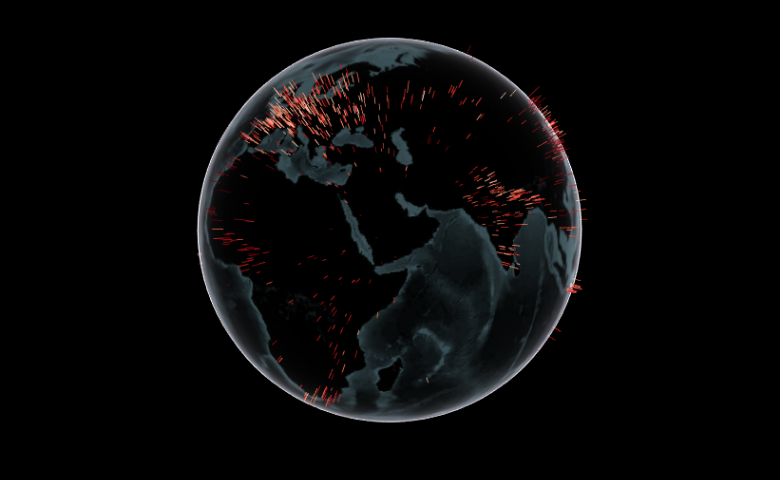
What Are Your Chances of Being Hit by a Meteorite?

Have you ever wondered how likely it is that you'll be hit by a meteorite? Never fear, we've analyzed the data and are ready to save the day! Learn where you should stand to avoid space debris!
For this analysis, we used this dataset, publicly available from NASA. It contains over 45,000 meteorites, with details of their mass, age, when and where they fell. We don't know when most of the meteorites in this dataset fell; we're going to be focusing on the 1107 meteorites that have been recorded as they fell.
Where have meteorites fallen?
First, let's see where on the globe all these meteorites have fallen. A lighter line indicates that the fall happened longer ago; a darker line indicates a more recent fall. The larger the meteorite, the longer the line it is represented by. You can interact with the globe with your mouse, or view and edit the original dashboard and R code by clicking the button below.
Explore the original dashboard
This seems to show that meteorite hits are concentrated around certain areas. This raises the question: are meteorites more likely to fall in certain places? There is some research to suggest that meteorites might be more likely to fall closer to the equator. However, this hypothesis doesn't appear to be borne out by our data. There is no obvious clustering around the equator visible on our globe.
Meteorites and land area
So, our meteorites don't seem to be more likely to fall at the equator. Here's another hypothesis: they're falling completely at random. If this was true, we would expect a reasonably even distribution around the globe. By this logic, the bigger a country's land area, the more meteorites should fall there. To examine this, let's chart each country by the number of meteorites in our dataset that fell there.
Avoid the United States! Our dataset contains 145 meteorites that have fallen there. India also looks dangerous, with 124 meteorites having fallen there.
This map makes it pretty clear that there's not an even distribution according to land area. If our hypothesis was correct, Russia and Canada should both have a higher number of meteorite hits than the United States.
We can chart the land area of countries against the number of meteorites that fell there. From the scatterplot below, we can see that there is a weak relationship. If the number of meteorites fallen was correlated with land area, we would expect to see a linear relationship. Clearly, this is not the case.
If we chart the number of meteorites we would expect to see if meteorites fell in a linear relationship with land area, this is what it looks like.
Compared to the map made from the real meteorite data, this looks very different. Obviously, land area does not determine how many meteorites fall in certain countries. But if that's the case, then what does?
Meteorites and reporting bias
Rather than being related to land area, it actually seems as though meteorite strikes are related to population size. India and the United States, the two countries with the most meteorite hits, are both densely populated. This is likely indicative of a reporting bias, as meteorites are more likely to be seen and reported if they fall in densely populated areas.
Just as there's a large reporting bias in favour of meteorites that fall in densely populated areas, there's also a bias in favour of larger meteorites. This is logical, as a one kilogram meteorite is going to be much more noticeable than a ten gram meteorite. The chart below shows all the meteorites that have fallen in the last 10 years. As you can see, there are far more meteorites over 1 kilogram (shown in red) than under 1 kilogram (50 g - 1 kg is shown in yellow; under 50 g is shown in green).
Explore the original dashboard
However, it's not all doom and gloom! The odds of being hit by a meteorite are extremely low. You're far more likely to die in a car crash or a fire than you are to die from a meteorite strike. It's also more likely that you'll be killed by lightning or a tornado - both of which are extremely rare. However, there's bad news too - you have a higher chance of being hit by a meteorite than you do of winning the lottery.
All the visualizations in this post were made by writing R code in Displayr. You can create online, shareable dashboards with R code - and best of all, it's free!
Learn more about creating online dashboards here!



